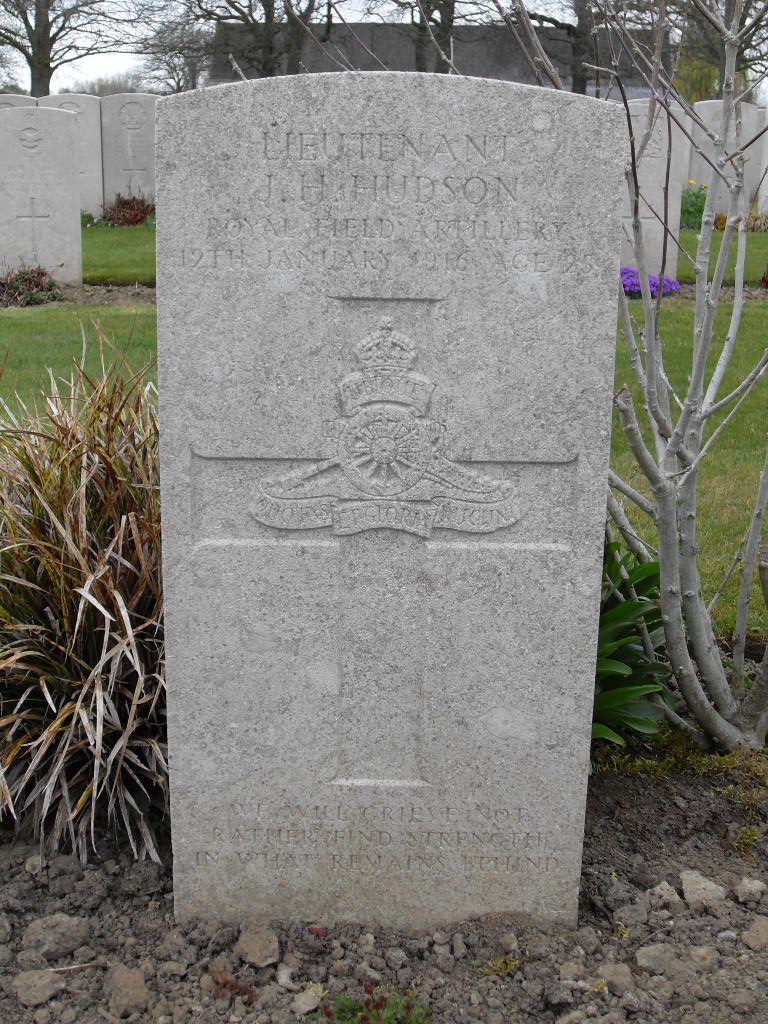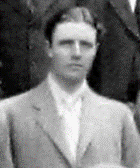Fact file:
Matriculated: 1907
Born: 24 April 1889
Died: 12 January 1916
Regiment: Royal Field Artillery
Grave/Memorial: Lijssenthoek Military Cemy, Poperinge; Grave II.A.25.
Family background
b. 29 April 1889 at 60, Park Street, Park Lane, London W1, as the second son of Robert William Hudson (1856–1938) and his first wife, Gerda Frances Hudson Bushel Hudson (née Johnson) (1857–1932) (m. 1886). At the time of the 1891 Census the family was living at Athelstone, Birkenhead Cheshire (five servants); by the time of the 1901 Census the family was living at Danesfield House, Marlow, Buckinghamshire (five servants); it does not feature in the 1911 Census but after Jocelyn Hudson’s death it lived at “Queensmere”, Wimbledon Park, London SW19.
Parents and antecedents
Hudson’s father was the eldest son of the druggist and chemist Robert Spear Hudson (later JP) (1812–84), who, in 1837, founded a small firm in the High Street of West Bromwich, his native town, that made coarse bar soap into dry soap flakes for the commercial market. Previously people had had to do this work themselves and Hudson’s experiments with soap were initially undertaken to help his wife, who found such work hard and painful because she suffered from rheumatism. The idea caught on and by 1854 Robert Spear’s little factory employed ten women. Indeed, Hudson’s Dry Soap gradually became a household name, due in part to its founder’s flair for striking and innovative advertising that made use of pictures and slogans. In the 1860s, following the death of his first wife, Robert Spear’s increasing prosperity enabled him to move his home from West Bromwich to Bache Hall, Chester, and in 1875 his firm moved its head office to Bootle, Lancashire, and its main factory to Bank Hall, Liverpool, where it could take advantage of better rail and river connections. The factory ultimately employed around a thousand people and produced such well-known brands of soap powder as “Rinso” and “Omo”. A committed Liberal and a devout Congregationalist – Robert Spear’s father had been a Congregationalist minister – Robert Spear was very active in many areas of public life, especially education, and bequeathed much of his estate (£300,000 – c.£12,000,000 in 2005) to churches and charity.

Advertisement for Hudson’s soap from London Daily News 18 May 1889
After his father’s death, Hudson’s father, Robert William, became the proprietor of Hudson’s and managed the firm until it was acquired in 1907–08 by the even more successful Lever Brothers for £1,000,000 (the equivalent of c.£40,000,000 in 2005). Robert William had a passion for old houses and in 1891, taking his inspiration from Little Moreton Hall, Cheshire, he commissioned the architect Edward Ould (1852–1909) to build Bidston Court in Vyner Road, Bidston, Birkenhead, where his daughter Violet was born. The design so impressed Crown Prince William of Prussia that he had the so-called “Cecilienhof” built in Potsdam (1914–17) along similar lines: it was here that Truman, Churchill and Stalin would sign the Potsdam Accord in 1945. Sometime in the 1890s, Robert William began to spend more time in Buckinghamshire, for in 1901 he, his family and six servants were living on the Danesfield estate, near Marlow. He became High Sheriff of Buckinghamshire in 1903, and according to Kelly’s Directory he and his family were living permanently at Danesfield House in 1907. But Robert William did not sell Bidston Court until 1921. Soon after the death of his first wife, Robert William married Beatrice Sabina Gaudengio (d. 1950), the daughter of Laurenzo Gaudengio from Lucca, Italy, and moved to the Villa La Paloma, Monaco. He died either there or in Aix-les-Bains in 1938. His widow died in 1950 in the Villa La Paloma, leaving an estate worth £152,743 14s. 10d.
Siblings and their families
Brother of:
(1) Robert Spear (1st Viscount Hudson of Pewsey, in Wiltshire, from 1952) (1886–1957); married (1918) Hannah Randolph (1890–1969); one son (later 2nd Viscount);
(2) Violet Francesca Rosalind (1898–1975).

The two boys sitting on ponies outside Bidston Court, Birkenhead, are believed to be Robert Spear (right) and Jocelyn Hope (left). The photograph was taken for Robert William Hudson by H. Bedford in July 1894 and is reproduced here by kind permission of Historic England (Ref. no. BL 12855B).
Robert Spear was educated at Eton and Magdalen from 1906 to 1909 and was awarded a 2nd in History. While at Oxford he played for the University polo team from 1907 to 1910 and captained it from 1909 to 1910. He then entered the Diplomatic Service, but when war broke out he was commissioned Second Lieutenant in the newly formed 5th (Reserve) Regiment of Cavalry (1,324 ORs (other ranks), 547 horses), where, for two weeks (1–16 November 1914), one of his brother officers was Lieutenant G.F.A. Pigot Moodie, the brother of Charles Alfred Pigot-Moodie. On 10 April 1915 Robert resigned his commission on the grounds of ill health – so he never saw active service. He returned to the Diplomatic Service, retired as a First Secretary in 1923, and then went into politics, becoming the Conservative MP for Whitehaven, Cumberland (now Cumbria), from 1924 to 1929 and Southport, Lancashire (now Merseyside), from 1931 to 1952. He held down several junior ministerial posts in the 1930s and acquired a reputation of being someone who worked hard, spoke plainly, got things done and promoted the interests of British trade: “able, masterful and energetic, he made up for a somewhat brusque manner by the force of his intelligence”. In 1938 he was invested as a Privy Councillor.
But it was as the Minister for Agriculture and Fisheries in the Churchill administration (May 1940–45) that he enjoyed his most “spectacular success”. A farmer in his own right who bred prize-winning pedigree cattle, he instituted the Agricultural Improvement Council and the Women’s Land Army, and his success was so spectacular that in July 1942 he was able to announce that Britain was now producing two-thirds of its own food, thereby freeing up large quantities of shipping for other, more directly military purposes. His obituarist in The Times called him “the leader of an agricultural revolution”. On leaving politics in 1952, he was created 1st Viscount Hudson of Pewsey in Wiltshire but the title became extinct after the death of his only son, Robert William Hudson, the 2nd Viscount (1924–63).
Education
From c.1896 to December 1901 (see also C.F. Cattley, G.W. Cattley) Hudson attended Mr Arnold’s Preparatory School, Wokingham, Berkshire. (The school was founded in 1869 as Wixenford School when the Reverend Richard Cowley Powles (1819–1901; Headmaster 1869–79) leased Wixenford House; in 1888, Ernest Penrose Arnold (b. c.1848 in Berlin, d. 1917), Powles’s successor from 1879 to 1903 and a nephew of Dr Thomas Arnold of Rugby (1795–1842), moved the school into Wokingham, where it became known as Mr Arnold’s Preparatory School; it has been defunct since 1934.) Hudson then studied at Eton College from January to March 1902 and matriculated at Magdalen as a Commoner on 15 October 1907; it is not known how he spent the intervening five years, but he was presumably at school somewhere, possibly in Canada.
Hudson was partly exempt from Responsions as he had passed the Literature paper in September 1907 and had a London Maths Certificate. He took part of the First Public Examination in Trinity Term 1908, when he was awarded a 2nd in Mathematics Moderations, and the second part (Holy Scripture) in Hilary Term 1909. He then read for an Honours Degree in Natural Sciences and was awarded a 3rd in Physics in 1910. He took his BA on 27 May 1911. President Warren wrote of him posthumously: “Brought up amid wealth and luxury, he was far from luxurious. He had considerable gifts and versatile tastes, divided between physics, mechanics, and art.” Hudson was also keen on boxing and polo, captaining the University team in 1911, and he was a master of Japanese wrestling. In 1908 he formed a wrestling club with premises in St Aldates and was described as being “a fine exponent of the Jiu-Jitsu style”. When making his will, he gave his address as Queensmere, Wimbledon.

Jocelyn Hope Hudson (1909)
(Photograph taken in Magdalen)
War service
Hudson, who was 6 foot tall, trained in the Inns of Court Officers’ Training Corps (“The Devil’s Own”) and Leeds University Officers’ Training Corps, and applied for a Commission on 17 August 1914. On 1 October 1914 he became a probationary Second Lieutenant (London Gazette, no. 28,922, 2 October 1914, p. 7,812), in ‘C’ Battery, 4th West Riding (Howitzer) Brigade, Royal Field Artillery (Territorial Force), part of the 14th (Light) Division, and he was confirmed in this rank on 19 August 1915.
By April 1915 the 4th West Riding (Howitzer) Brigade had become the 49th Brigade, Royal Field Artillery, and it left Aldershot on 18 May 1915, arrived at Southampton on the following day, and disembarked at Le Havre on 20 May 1915. It remained here for the next three months as part of 146th (Infantry) Brigade, in the 49th (West Riding) Division, and then, from 1 September, it was attached to 46th (Midland) Division. During this period it provided artillery fire for the counter-attack at Hooge by the 6th and 14th Divisions (8 August; see B. Pawle and J.J.B. Jones-Parry), for the Battle of Polygon Wood (25 September), and for the British diversionary attack on the north-east edge of the Ypres Salient when the Germans used phosgene gas for the first time (19 December). On 24 December, the Battery was withdrawn westwards from Potijze to rest at Vlamertinghe for a week, and on 30 December Hudson became a subaltern in its ‘C’ Troop. Two days later the Battery was at Elverdinghe, just to the north-west of Ypres, providing retaliatory fire in support of the infantry, and it was here that Hudson was mortally wounded by a shell on 11 January 1916.

Lijssenthoek Military Cemetery, Poperinghe; Grave II.A.25
He died of wounds received in action, aged 25, on 12 January 1916, probably in or near No. 10 Casualty Clearing Station at Abeele, just south-west of Poperinghe, Belgium, and was buried at first in the Soldiers’ Cemetery, Hilhoek, south of Poperinghe. His body was subsequently transferred to nearby Lijssenthoek Military Cemetery (the second largest military cemetery in Belgium), Grave II.A.25, which is inscribed: “We will grieve not, rather find strength in what remains behind” (William Wordsworth, ‘Intimations of Immortality’, lines 184–5). Hudson left £62,465 9s 11d.
Bibliography
For the books and archives referred to here in short form, refer to the Slow Dusk Bibliography and Archival Sources.
Printed sources:
[Thomas Herbert Warren], ‘Oxford’s Sacrifice’ [obituary], The Oxford Magazine, 34, no. 9 (28 January 1916), p. 145.
[Anon.], ‘Marlow’ [brief death notice], The Bucks Free Press (17 June 1938), p. 6.
[Anon.], ‘Lord Hudson’ [obituary], The Times, no. 53,756 (4 February 1957), p. 12.
Charles Wilson, The History of Unilever: A Study in Economic Growth and Social Change, 3 vols (London: Cassell, 1970).
Nigel Lemon, ‘A Blackcountryman at Bache Hall’, Cheshire History, 46 (2006–7), pp. 91–103.
Archival sources:
OUA: UR 2/1/63.
WO95/1887.
WO95/5455.
WO339/18258.
